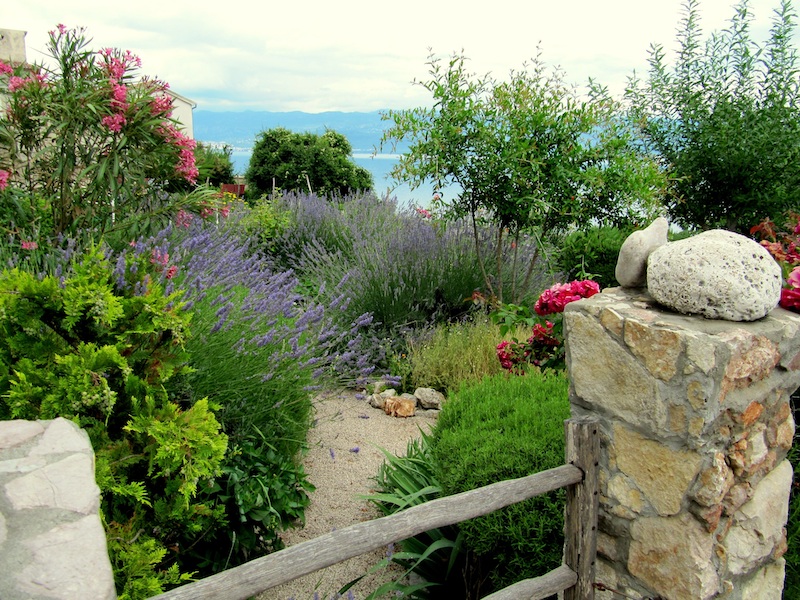Lavender is a fabulous woody perennial that works well in numerous locations in the garden. Plant this Mediterranean stalwart as part of an herb garden, kitchen garden, informal pollinator garden, low-growing hedge, or waterwise garden for color, fragrance and low maintenance. The main requirement of lavender is well-draining, loose soil that does not experience seasonal flooding. Lavender is not a hungry plant and rarely requires supplemental fertilizing. It pairs well with other xeric or waterwise plants and is well-behaved among small, delicate plants.

Shrubs To Plant With Lavender
The swaying flower spikes of lavender look amazing on a hot summer day when set against a backdrop of other Mediterranean shrubby favorites. The smell of the foliage and flowers is unmistakable and coveted as a cure for many ailments including insomnia and stress. Use upright rosemary, woody or large-leaved sage, and oleander to construct a sunny oasis near a patio or deck where the fragrance of all the plants can be enjoyed. Plant lavender at the top of a rock wall along with prostrate rosemary, spreading thyme or a rambling rose to soften the hardscaping with tough, dependable plants that need little care.
Lavender also can be planted alongside more traditional xeric plants like cacti, yucca, and New Zealand flax to add a hit of purple, blue, or white color through the summer months. Supplemental watering will be needed for the lavender until it is established.
Perennials To Plant With Lavender
Lavender makes a good neighbor for a long list of perennials. Almost any garden plan can include lavender’s pollinator-attracting flower spikes as long as the site is in full sun and has good drainage. For modern designs, pair lavender with agapanthus, alliums, globe artichoke, and euphorbia, which provide strong, architectural shapes and some unexpected edible options. More traditional plantings with cranesbill, lamb’s ear, artemisia, and agastache mix well with lavender in cottage gardens or pollinator gardens.

Annuals To Plant With Lavender
Hot weather annuals are perfect for adding contrasting or complementary colors to a garden bed with lavender. Flowering vinca, New Guinea impatiens, moss rose, and lantana thrive in full sun and have bright and cheerful colors that pop against the silvery foliage of a lavender plant. Other sun-loving companions include cosmos, zinnias, snapdragons, globe amaranth, and California poppies.
Most of these annuals will self-seed in the garden bed, increasing the longevity of the planting. Using annuals as bedding plants allows the gardener to change planting schemes and color combinations every year or even on a seasonal cycle if desired.
Best Companion Plants For Lavender in Containers
Plant lavender as the thriller in a low-maintenance container for the deck or patio in full sun. Brachyscome, alyssum, and calibrachoa make great fillers and spillers to highlight the silver foliage and deep purple flowers of lavender. Lavender is also useful planted alongside other edible herbs and flowers for use in the kitchen. In a large container, combine lavender with thyme, sage, chives, and tarragon, which are all perennial plants that can grow together for a few years before requiring repotting. If the planter is large enough, tuck in a couple of edible calendula or nasturtium plants as fillers to add extra color to the container or a salad.

Plants Not To Grow With Lavender
Lavender is often combined with roses in the landscape even though this combination typically does not suit both plants. Both plants thrive in full sun, but lavender requires far drier soil and much less fertilizing than roses to perform at its best. Native roses are better choices to grow near lavender, although their aggressive sucker growth may eventually overwhelm any plants in the area.
The inner zones of a rain garden are also not ideal for growing lavender. Plants in zones one, two, or even three need to be able to tolerate seasonal flooding either in the winter or summer. The outer transitional zones tend to stay dry enough to accommodate lavender, although native plants for your climate usually are the best choices.
Best Plants To Grow With Lavender
Xeric landscapes with other Mediterranean or subtropical plants are where lavender is most at home. Excellent-draining soil and full sun go a long way to keeping lavender thriving and mostly trouble-free. Use arborvitae, olive, and oleanders as a backdrop for a lovely rock garden-inspired space. Underplant with a wide variety of lavender for long-lasting color in the summer months.
 |
Author Robbin Small - Published 10-09-2023 |
